What types of test modes are supported on the Dansensor Lippke 5000?

The Dansensor Lippke 5000 is a versatile and programmable instrument designed for comprehensive package integrity testing. It supports multiple test modes, each addressing specific requirements for detecting leaks, assessing seal strength, and ensuring package robustness — especially in industries like medical device packaging, food MAP packaging, and pharmaceuticals.
Below are the main test modes available on the Lippke 5000:
🟥 1. Burst Test
What it does:
Applies internal pressure to a package until it bursts. This test identifies the maximum pressure the package or seal can withstand before failure.
Why it matters:
Crucial for validating seal strength and packaging process stability — especially for high-integrity sterile barrier systems.
Standard reference:
- ASTM F1140
- ISO 11607-1 / ISO 11607-2
Common application:
- Blister packs for medical syringes
- MAP food trays
- Vacuum-sealed pouches
🟨 2. Creep Test
What it does:
Applies pressure and holds it at a constant level for a specified time, monitoring if the seal weakens or if there’s any pressure loss.
Why it matters:
Simulates shelf-life conditions and seal durability under constant stress, helping identify weak or inconsistent sealing areas.
Standard reference:
- ASTM F2054
Common application:
- Long-term stored medical or food products
- Packages exposed to altitude or pressure changes
🟦 3. Creep-to-Failure Test
What it does:
Similar to the creep test, but instead of stopping at the end of a time limit, it continues until the package fails — either by bursting or leaking.
Why it matters:
Gives a quantitative threshold of seal strength and how long a package can sustain pressure over time.
Standard reference:
- ASTM F1140
Common application:
- Comparative validation of different sealing machine settings
Shelf-life stress simulations
🟩 4. Leak Test
What it does:
Inflates the package to a defined pressure, then monitors for pressure drop over time — indicating possible microleaks.
Why it matters:
Detects small, invisible breaches that may compromise sterile barriers or shelf life, without visibly damaging the package.
Standard reference:
- ASTM F2338 (Vacuum decay variation)
Common application:
- Pharma blister packs
- Flow wraps
- Retort pouches
🟫 5. Bubble Emission (Submersion) Test
What it does:
The package is inflated and submerged in water. Visible bubbles indicate leak locations — useful for root cause analysis.
Why it matters:
A simple and visual test for detecting pinholes or channel leaks, especially after transport simulation or stress tests.
Standard reference:
- ASTM F2096 (modified with pressure inflation)
Common application:
- Leak location verification after other failed tests
- Troubleshooting sealing line malfunctions
Click here to know more.
